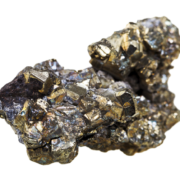Pyrite: Properties, Uses and Virtues
Pyrite forms in environments rich in iron and sulphur, such as hydrothermal zones or marine sediments. It is distinguished by its golden colour and metallic sheen. Often confused with gold and referred to as “fool’s gold”, pyrite is widely distributed around the world and has been used throughout history for a variety of applications, including the creation of artistic and ritual objects and the production of sulphur.
It is associated with energy, prosperity and protection against negative energies on a metaphysical level. Pyrite is relatively resistant, with a hardness of 6 to 6.5, but can deteriorate and disintegrate over time, especially in the presence of acid, and is sensitive to impact.
It can be treated to improve its shine, but imitations are rare due to its natural abundance. For maintenance, we recommend cleaning it regularly with a soft, dry cloth.

Pyrite: Table of contents
- The Short Version For Busy People
- Geological formation
- Rough pyrite – A brilliant gem
- History of pyrite – Through the ages
- Metaphysical properties of pyrite
- Pyrite varieties
- Pyrite colors
- Durability and wearability of pyrite
- Pyrite improvements
- Synthetic pyrite and imitations
- Pyrite imitation
- Pyrite care
- Sources
Geological formation
Pyrite forms mainly in geological environments rich in iron and sulphur, such as areas where hydrothermal fluids flow through rocks. These fluids react with the surrounding minerals to create pyrite, which appears in the form of crystals or masses. It can also form in marine sediments rich in organic matter. Pyrite is distinguished by its characteristic golden colour and metallic sheen, making it easy to recognise.
Rough pyrite – A brilliant gem
Rough pyrite often has a shiny crystalline surface, with distinctive cubic or octahedral shapes.
Its shimmering golden colour gives it the appearance of gold, hence its nickname of “fool’s gold”. However, unlike gold, pyrite is a mineral rather than a metal. It also resembles marcasite, which is very similar but less stable and very brittle.
Sources – The global presence of pyrite
Pyrite is widespread throughout the world. It is found in a variety of geological environments, including hydrothermal seams, sedimentary deposits and even metamorphic deposits. Notable deposits are found in Spain, Peru, Italy, the United States and Australia, among other regions.
History of pyrite – Through the ages
Throughout history, pyrite has been used in a variety of applications.
Ancient masks have been found in Peru, made of shells, copper and pyrite and dating from 100 B.C.E (before Christ) to 500 C.E.
Polished pyrite mirrors with various jade mosaics have been found in Mexico and dated to Mesoamerica, between 500 and 600 BC.
In the Middle Ages, it was sometimes mistaken for gold, hence its nickname of “fool’s gold”. Some alchemists even believed that they could transform pyrite into gold, thus contributing to its mystique.
In his research into the creation of silver and mercury pollution in South America between 1580 and 1900, Jerome O Nriagu describes the ‘patio’ process for creating silver, which uses roasted iron or copper pyrite.
More recently, in the 18th century, pyrite was used in the production of sulphur and sulphuric acid. During the First World War, it was also used in the production of munitions.
M. Henckel dedicated a complete work to it in 1760, entitled “Pyritologie, ou Histoire Naturelle de la Pyrite”.
Today, pyrite is mainly used as a decorative material in the manufacture of jewellery and objets d’art. Its metallic lustre and golden colour make it a popular choice for artistic creations.
Metaphysical properties of pyrite
Metaphysically speaking, pyrite is often associated with energy, vitality and prosperity. It is said to attract wealth and promote self-confidence. Some also believe it offers protection against negative energies and promotes physical and emotional well-being.
Pyrite varieties
Pyrite has many varieties in mineralogical terms, i.e. in terms of its chemical composition. However, in gemmological terms, pyrite is generally considered as a whole.
Pyrite colors
Pyrite’s golden colour is due to the presence of traces of iron in its chemical composition.This colour can vary in intensity depending on the impurities present in the mineral. Under specific conditions, pyrite can also show iridescent to red reflections (liver pyrite).
Durability and wearability of pyrite
Pyrite is a relatively resistant mineral with a hardness of 6 to 6.5 on the Mohs scale. However, it can deteriorate over time when exposed to air and moisture, sometimes forming iron rust. As mentioned in my article on stones you should never wear in a swimming pool, exposure to acid can severely deteriorate the stone to the point of disintegration. Pyrite is also relatively sensitive to impact. We therefore recommend storing it in a dry place and handling it with care.
Pyrite improvements
Pyrite is sometimes treated to improve its brilliance or stability. However, treatments are generally minimal and rare, as the stone is already naturally attractive and often appreciated in its natural rough form rather than as jewellery.
Synthetic pyrite and imitations
Synthetic pyrite exists, particularly for scientific purposes. It is not generally available on the market.
Pyrite imitation
Because of its natural abundance, pyrite is rarely imitated.
Pyrite care
To preserve the beauty and integrity of pyrite, we recommend cleaning it regularly with a soft, dry cloth to remove dust and residues. Avoid letting pyrite come into contact with aggressive chemicals or corrosive liquids, as this could damage its surface.
Sources
NRIAGU, Jerome O. Silver Production and Mercury Pollution in South America Between 1580 and 1900. EXTRACTION, 1700, vol. 1300, no 1500.
HENCKEL, Johann Friedrich. Pyritologie ou Histoire naturelle de la pyrite: ouvrage dans lequel on examine l’origine, la nature, les propietés & les usages de ce Minéral important & de la plupart des autres substances du meme regne: on y a joint le Flora saturnisans… et les opuscules minéralogiques.. chez Jean-Thomas Hérissant, 1760.



Leave a Reply
Want to join the discussion?Feel free to contribute!